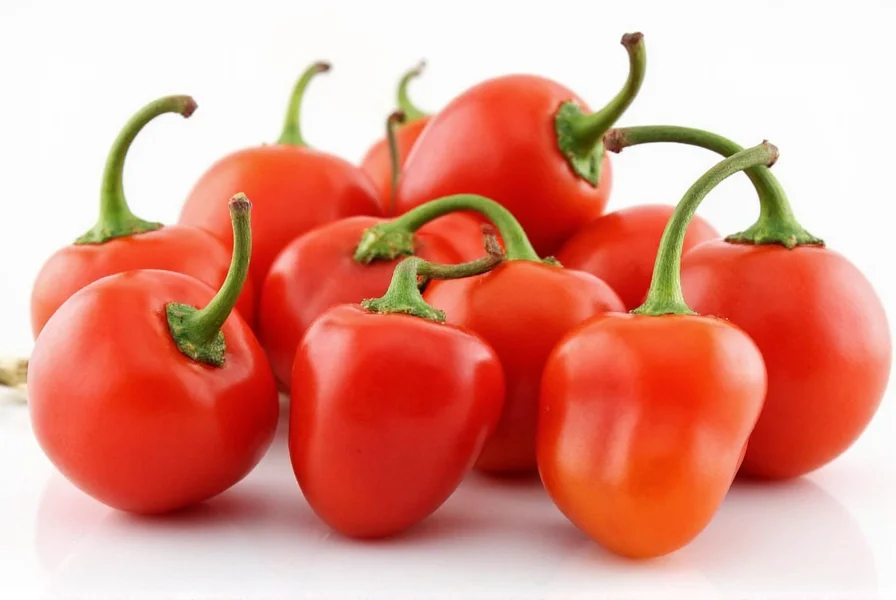Table of Contents
Introduction to Chili Petin
Chili Petin is not a standard chili variety — it's a common misspelling or regional name for bird's eye chili (also known as Thai chili). This small but fiery pepper is widely used in Southeast Asian cuisine. In this guide, we'll clarify the confusion and provide accurate information about bird's eye chili, including its heat level, uses, and comparisons.
Spice Basics: What is Bird's Eye Chili?
Bird's eye chili (often mistakenly called "Chili Petin") is a small, potent chili pepper originating from Southeast Asia. It's a staple in Thai, Vietnamese, and Indonesian cooking. Unlike bell peppers or jalapeños, bird's eye chili packs intense heat, typically ranging from 50,000 to 100,000 Scoville Heat Units (SHU). Its name comes from its tiny size (about the size of a bird's eye), not from any relation to "Petin."
The term "Chili Petin" likely stems from regional mispronunciations or translation errors. Scientifically, it's classified as Capsicum frutescens and is distinct from Tabasco peppers (used in Tabasco sauce), which are a separate variety. Despite the confusion, bird's eye chili has a unique flavor profile: sharp, citrusy, and slightly sweet with a lingering heat.

Practical Tips for Using Bird's Eye Chili
Now that you know bird's eye chili is the correct term (not "Chili Petin"), here are practical tips for using it effectively:
- Start Small: Due to its intense heat, begin with just one chili and adjust to taste. A single pepper can spice up an entire dish.
- Use Fresh or Dried: Fresh bird's eye chilies are ideal for salsas, stir-fries, and sauces. Dried versions work best in spice blends, marinades, or infused oils.
- Pair with Cooling Ingredients: Balance the heat with yogurt, coconut milk, lime, or honey. This prevents overwhelming your palate while enhancing flavor complexity.
- Infuse Oils and Vinegars: Create homemade spicy condiments by steeping bird's eye chilies in olive oil or vinegar. Perfect for dressings, dips, or drizzling over dishes.
- Make Authentic Hot Sauce: Use fresh bird's eye chilies to craft traditional Thai or Vietnamese hot sauces. Control the heat level and preserve freshness without additives.
A Comparison Table: Bird's Eye Chili vs. Other Chilies
To help you understand bird's eye chili's position among common chilies, here's an accurate comparison:
| Chili Type | Heat Level (SHU) | Flavor Profile | Common Uses |
|---|---|---|---|
| Bird's Eye Chili (often called "Chili Petin") | 50,000 - 100,000 | Sharp, citrusy, slightly sweet | Thai curries, sambals, stir-fries, hot sauces |
| Jalapeño | 2,500 - 8,000 | Mild, grassy, slightly smoky | Salsas, nachos, stuffed peppers |
| Habanero | 100,000 - 350,000 | Fruity, floral, intense heat | Hot sauces, Mexican dishes, salsas |
| Tabasco Pepper | 30,000 - 50,000 | Tangy, vinegar-like, moderate heat | Tabasco sauce, marinades, Bloody Marys |
| Ghost Pepper | 850,000 - 1,040,000 | Extremely hot, earthy, smoky | Super-spicy sauces, challenge recipes |

Buying Guide: How to Choose the Best Bird's Eye Chili
When shopping for bird's eye chili (not "Chili Petin"), consider these factors for quality:
Types of Bird's Eye Chili
- Fresh: Look for bright red, firm, glossy pods. Avoid soft, wrinkled, or discolored ones. Store in the refrigerator for up to 2 weeks.
- Dried: Choose dark red, brittle chilies with a strong aroma. Ensure no mold or moisture. Keep in airtight containers away from light for up to 1 year.
Key Features to Look For
- Origin: Authentic bird's eye chili comes from Thailand, Vietnam, or Indonesia. These regions produce the most flavorful varieties.
- Quality: Opt for organic or non-GMO options if used raw. Check for certifications like USDA Organic or Fair Trade.
- Source: Purchase from reputable spice retailers, Asian grocery stores, or trusted online sellers specializing in international ingredients.
Best Products for Different Use Cases
Here are recommended options based on your needs:
- For Authentic Thai Dishes: Fresh Bird's Eye Chili — Ideal for curries and stir-fries due to vibrant flavor and texture.
- For Long-Term Storage: Dried Bird's Eye Chili — Perfect for spice blends, soups, and marinades without altering dish texture.
- For Quick Cooking: Bird's Eye Chili Paste — Ready-to-use in sauces, dressings, or dips for consistent heat.
Whether you're a home cook or professional chef, choosing authentic bird's eye chili ensures the best flavor and heat profile for your recipes.
Frequently Asked Questions About Bird's Eye Chili
Is "Chili Petin" the same as bird's eye chili?
Yes — "Chili Petin" is a common misspelling or regional name for bird's eye chili. The correct scientific and culinary term is "bird's eye chili" or "Thai chili." There is no distinct variety called "Chili Petin."
How should I store bird's eye chili to keep it fresh?
Fresh bird's eye chili can be stored in a paper bag in the refrigerator's vegetable drawer for up to 2 weeks. For longer storage, freeze whole chilies in an airtight container for up to 6 months. Dried bird's eye chili should be kept in an airtight container away from light and moisture, where it maintains potency for up to a year.
What are good substitutes for bird's eye chili if I can't find it?
Good substitutes include Thai bird's eye chili (same variety), serrano peppers (milder, 10,000-23,000 SHU), or a mix of cayenne pepper and a small amount of habanero for citrus notes. For dried versions, crushed red pepper flakes with a touch of dried habanero work in a pinch.
Is bird's eye chili the same as Tabasco pepper?
No. Tabasco pepper (from Mexico) is a different variety used in Tabasco sauce, with lower heat (30,000-50,000 SHU) and a tangy, vinegar-like flavor. Bird's eye chili is Southeast Asian, with sharper heat and citrus notes. "Chili Petin" confusion sometimes leads to this mix-up.
How can I reduce the heat if I've added too much bird's eye chili to my dish?
Add dairy (yogurt, cream), acids (lime juice, vinegar), or sweetness (honey, sugar). Increase volume with non-spicy ingredients. Remember: capsaicin is oil-soluble, so coconut milk or fatty ingredients work best to neutralize heat.
What safety precautions should I take when handling bird's eye chili?
Always wear gloves when cutting or seeding. Avoid touching your face or eyes. Wash hands thoroughly with soap and water after handling. If chili juice contacts eyes, flush with cold milk (not water) since capsaicin is fat-soluble.
Conclusion
In conclusion, "Chili Petin" is not a real chili variety — it's a common misspelling for bird's eye chili. This small but powerful pepper is a cornerstone of Southeast Asian cuisine, offering sharp heat and citrusy notes that elevate dishes when used correctly. By understanding the correct terminology and proper usage, you can confidently incorporate bird's eye chili into your cooking.
Remember: Always start with a small amount, pair with cooling ingredients, and prioritize fresh, high-quality sources. Whether you're making authentic Thai curries or experimenting with homemade hot sauce, bird's eye chili is an ingredient worth mastering — not misnaming.
So embrace the truth: Skip "Chili Petin" and cook with bird's eye chili for authentic, fiery flavor!











 浙公网安备
33010002000092号
浙公网安备
33010002000092号 浙B2-20120091-4
浙B2-20120091-4